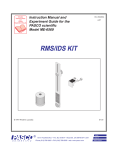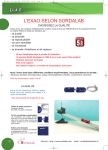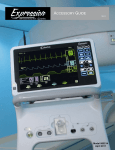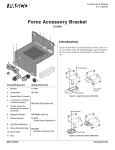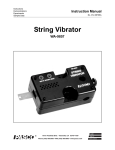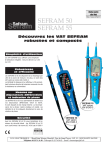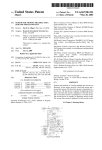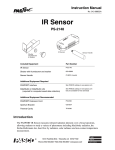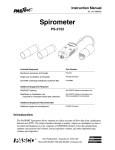Download PASCO Specialty & Mfg. 2.2m User's Manual
Transcript
Instruction Manual and Experiment Guide 012-05024G ® *012-05024* 2.2 m Classic Dynamics System ME-9452A 2.2 m Classic Dynamics System T a b l e o f C o n t e n ts Introduction . . . . . . . . . . . . . . . . . . . . . . . . . . . . . . . . . . . . . . . . . . . . . . . . . . . . . . . . . . . 5 About the Equipment . . . . . . . . . . . . . . . . . . . . . . . . . . . . . . . . . . . . . . . . . . . . . . . . . . . . 6 Spare Parts . . . . . . . . . . . . . . . . . . . . . . . . . . . . . . . . . . . . . . . . . . . . . . . . . . . . . . . . . . . 9 About the Experiments. . . . . . . . . . . . . . . . . . . . . . . . . . . . . . . . . . . . . . . . . . . . . . . . . . . 9 Experiment 1: Conservation of Momentum in Explosions . . . . . . . . . . . . . . . . . . . . . . . 11 Experiment 2: Conservation of Momentum in Collisions . . . . . . . . . . . . . . . . . . . . . . . . 13 Experiment 3: Simple Harmonic Oscillator . . . . . . . . . . . . . . . . . . . . . . . . . . . . . . . . . . 15 Experiment 4: Oscillations on an Incline . . . . . . . . . . . . . . . . . . . . . . . . . . . . . . . . . . . . 18 Experiment 5: Springs in Series and Parallel. . . . . . . . . . . . . . . . . . . . . . . . . . . . . . . . . 21 Experiment 6: Launch Speed. . . . . . . . . . . . . . . . . . . . . . . . . . . . . . . . . . . . . . . . . . . . . 23 Experiment 7: Newton’s Second Law . . . . . . . . . . . . . . . . . . . . . . . . . . . . . . . . . . . . . . 24 Experiment 8: Acceleration Down an Incline . . . . . . . . . . . . . . . . . . . . . . . . . . . . . . . . . 26 Experiment 9: Conservation of Energy . . . . . . . . . . . . . . . . . . . . . . . . . . . . . . . . . . . . . 29 Additional Experiment Suggestions . . . . . . . . . . . . . . . . . . . . . . . . . . . . . . . . . . . . . . . . 32 Technical Support . . . . . . . . . . . . . . . . . . . . . . . . . . . . . . . . . . . . . . . . . . . . . . . . . . . . . 34 2.2 m Classic Dynamics System ME-9452A 5 1 3 4 10 2 9 6 8 12 11 7 c 13 b a ® 4 Included Equipment Quantity Replacement Part Number 1. Plunger Cart 1 ME-9340 2. Collision Cart 1 ME-9454 3. 250 g Compact Cart Masses 2 ME-6755 4. 500 g Cart Mass 1 ME-6757 5. Adjustable End Stops 2 ME-8971 (2-pack) 6. 2.2 m Dynamics Track 1 ME-9779 7. Adjustable Feet 2 ME-8972 (2-pack) 8. Harmonic Springs 4 ME-9803 (3-pack) 9. Friction Block 1 ME-9807 10. Pivot Clamp 1 ME-9810 11. Super Pulley with Clamp 1 ME-9448A 12. Angle Indicator 1 ME-9495 13. Spring Cart Launcher with: ME-6843 a. Compression Springs 3 b. Release Pin 2 c. String ME-6847 (6 springs, 4 release pins) 1m Introduction The 2.2 m Classic Dynamics System includes everything you need for a variety of experiments and demonstrations. You can also combine it with many other PASCO products—both traditional and computer-based—for an even greater range of uses. This manual contains descriptions of the included equipment, complete instructions for nine experiments, and ten additional experiment suggestions. ® 5 2.2 m Classic Dynamics System About the Equipment About the Equipment Track The 2.2 m aluminum track has two groves to guide the wheels of carts, a metric scale for measuring cart positions, and T-slots on both sides for attaching end stops, leveling feet and other accessories. Tip: The track is designed to support the weight of carts and related apparatus. Excess weight will warp it. When you store the track, ensure that no heavy object will be placed on top of it. 1 2 3 Track Features 1: Grooves 2: Metric scale 3: T-slot 3 Plunger Cart and Collision Cart tion wheels. These carts run along the track on low-fric- The plunger cart includes a spring-loaded plunger that launches the cart off of an end stop or another cart. Push the plunger in to the first, second, or third “click” (for a slow, medium, or fast launch); then push up to make the trigger catch. To make the plunger pop out, tap the trigger button with a hard object (such the included 500 g mass). When the plunger is not in use, push it all the way in to the third position. For elastic and inelastic collisions, both carts have hook-and-loop bumpers on one end and magnetic bumpers on the other end. When the hook-and-loop bumpers collide, the carts stick to each other. When the magnetic bumpers collide, the carts repel each other without touching. The magnetic bumpers also repel the magnets in the end stops. The top or each cart forms a tray designed to hold the included masses. The carts also feature tapped holes for attaching accessories and sensors, and slots for holding a picket fence (such as PASCO part ME-9804) or the included angle indicator. For more information, see the manuals packaged with both carts. Cart Masses 1 2 Plunger Cart 1: Push plunger in. 2: Push up to lock. 3: Tap button to trigger. 1 2 3 Cart Features 1: Slots 2: Tapped holes 3: Bumpers These masses are designed to be placed on the upper tray of a cart. Cart Masses 6 ® Model No. ME-9452 A b o u t th e E q u i p m e n t Adjustable Feet Attach the feet to the track as illustrated. Turn the feet screws to level the track then tighten the lock nuts to secure them. For maximum stability, position the feet about 1/4 of the track length from each end 1 2 4 3 1/4 1/4 Adjustable Feet 1: Slide tab into T-slot. 2: Tighten thumbscrew to secure feet set. 3: Turn feet screws to level track. 4: Tighten lock nuts to secure feet screws. Adjustable End Stops Attach the end stops to the track as illustrated. The end stops contain magnets to repel the magnetic bumper of a cart. A stud is provided as an attachment point for a spring. 4 3 1 2 Adjustable End Stop 1: Slide tab into T-slot on side of track. 2: Tighten thumbscrew to secure end stop. 3: Magnets repel cart’s magnetic bumper 4: Spring attachment stud Harmonic Springs Ideal for studying harmonic oscillation of carts on a flat or inclined track, these spring hook onto holes at the ends of the carts and to studs on top of the end stops. The springs are packed in storage tubes, which include adhesive tape so that they may be permanently attached to the underside of the track. Harmonic Spring Friction Block The friction block has two different surfaces (wood and felt) and two different surface areas for studying friction. It includes an eye screw for attaching a string and slots on both broad surfaces for holding a picket fence (such as PASCO part ME-9804) or the included angle indicator. ® Friction Block 7 2.2 m Classic Dynamics System About the Equipment Pivot Clamp Attach the pivot clamp to the T-slot of the track (as illustrated) to elevate one end of the track on a vertical rod. T-slot Pivot Clamp Super Pulley with Clamp This low-friction, low-inertia pulley is designed for clamping onto the end of the track. Tie a string to the hole in the end of the cart an run it over the pulley. Adjust the height of the pulley to make the string parallel to the track. The pulley can also be mounted in the lower position as illustrated. Tie the string to the opposite end of the cart and wrap it underneath the cart. In the lower position, the string can be run under an end stop, another cart, or a motion sensor. Super Pulley with string in normal position (left) and lower position (right) Angle Indicator Attach the angle indicator to the track as illustrated, or remove the attachment screw and slip it into the slots of a cart or friction block. The hanging thread indicates the angle or incline. Angle Indicator on track Angle Indicator on cart Spring Cart Launcher This accessory is designed for the study of force and motion, potential energy, conservation of energy, the work-energy theorem, Hooke’s Law, and spring constants. Use it to launch either cart by compressing and releasing one of three interchangeable springs. The included release pin, in combination with two end stops, allows you to use precisely the same spring compression for multiple launches. Spring Cart Launcher For more information, see Experiment 9 on page 29 and the manual packaged with with the launcher. 8 ® Model No. ME-9452 Spare Parts Spare Parts You can order any of the major components of the system using the part numbers listed in the table on page 5. For an assortment of smaller parts, the following kits are available. IDS Spares Kit (ME-9823) and harmonic springs. This kit includes assorted thumbscrews, square nuts, Cart Launcher Springs Kit (ME-6847) This kit includes four compression springs and four release pins for the Spring Cart Launcher. For help identifying a part, contact PASCO technical support (see page 34). About the Experiments These nine experiments can be done with the equipment included in the system and other equipment commonly found in introductory physics labs. See each experiment for a specific equipment list. 1. Conservation of Momentum in Explosions (page 11): Demonstrate conservation of momentum when two carts push off from each other. 2. Conservation of Momentum in Collisions (page 13): Demonstrate conservation of momentum in elastic and inelastic collisions. 3. Simple Harmonic Oscillator (page 15): Study how the period of oscillation of a system varies with its mass. 4. Oscillations on an Incline (page 18): Study the oscillation of a cart attached to a spring on an inclined track. 5. Springs in Series and Parallel (page 21): Examine how springs combined in different ways affect the period of oscillation of a cart. 6. Launch Speed (page 23): Show qualitatively how the final speed of the plunger cart depends on its mass and the initial compression of the plunger spring. 7. Newton’s Second Law (page 24): Show quantitatively how the acceleration of a cart is related its mass and net force. 8. Acceleration Down an Incline (page 26): Determine the strength of earth’s gravity (g) by measuring the acceleration of a cart on an inclined track. 9. Conservation of Energy (page 29): Use the spring cart launcher to launch a cart up an incline. Compare the potential energy initially stored in the spring to the maximum gravitational potential energy achieved by the cart. Additional Experiment Suggestions (page 32): Many of these suggestions are variations on the above experiments. Some require additional carts. ® 9 2.2 m Classic Dynamics System 10 About the Experiments ® Model No. ME-9452 Experiment 1: Conservation of Momentum in Explosions Experiment 1: Conservation of Momentum in Explosions Required Equipment from Dynamics System Track with Feet and End Stops Plunger Cart Collision Cart Cart Masses Other Required Equipment Suggested Model Number Mass set ME-9348 Purpose The purpose of this experiment is to demonstrate conservation of momentum with two carts pushing away from each other. Theory When two carts push away from each other (and there is no net force on the system), the total momentum is conserved. If the system is initially at rest, the final momentum of the two carts must be equal in magnitude and opposite in direction to each other so the resulting total momentum of the system is zero: p = m1 v1 – m2 v2 = 0 Therefore, the ratio of the final speeds of the carts is equal to the ratio of the masses of the carts. v1 m ----- = ------1 v2 m2 To simplify this experiment, the starting point for the carts at rest is chosen so that the two carts will reach the ends of the track simultaneously. The speed, which is the distance divided by the time, can be determined by measuring the distance traveled since the time traveled by each cart is the same. x --------1- v1 x t ----- = --------------- = --------1v2 x 2 x --------2- t Thus the ratio of the distances is equal to the ratio of the masses: x 1 m --------- = ------1 x 2 m2 Procedure 1. Instal the feet on the track and level it. Install one end stop at each end with the magnetic sides facing away from the carts. ® 11 2.2 m Classic Dynamics System Experiment 1: Conservation of Momentum in Explosions Figure 1.1 2. For each of the cases in Table 1.1, place the two carts against each other with the plunger of one cart pushed completely in and latched in its maximum position (see Figure 1.1). 3. Tap the plunger release button with a short stick and watch the two carts move to the ends of the track. Experiment with different starting positions until the two carts reach the ends of the track at the same time. Measure the masses of the carts. Record the masses and the starting position in Table 1.1. Table 1.1: Results Additional Mass on Cart 1 Additional Mass on Cart 2 0 0 500 g 0 1000 g 0 500 250 m1 m2 Starting Position x1 x2 x 1/x 2 m 2/m 1 Data Analysis 1. For each of the cases, calculate the distances traveled from the starting position to the end of the track. Record the result in Table 1.1. 2. Calculate the ratio of the distances traveled and record in the table. 3. Calculate the ratio of the masses and record in the table. Questions 12 1. Does the ratio of the distances equal the ratio of the masses in each of the cases? In other words, is momentum conserved? 2. When carts of unequal masses push away from each other, which cart has more momentum? 3. When the carts of unequal masses push away from each other, which cart has more kinetic energy? 4. Is the starting position dependent on which cart has the plunger? Why? ® Model No. ME-9452 Experiment 2: Conservation of Momentum in Collisions Experiment 2: Conservation of Momentum in Collisions Required Equipment from Dynamics System Track with Feet Plunger Cart Collision Cart Other Required Equipment Paper (for drawing diagrams) Purpose The purpose of this experiment is to qualitatively explore conservation of momentum for elastic and inelastic collisions. Theory When two carts collide with each other, the total momentum of both carts is conserved regardless of the type of collision. An elastic collision is one in which the carts bounce off each other with no loss of kinetic energy. In this experiment, magnetic bumpers are used to minimize the energy losses due to friction during the collision. In reality, this “elastic” collision is slightly inelastic. A completely inelastic collision is one in which the carts hit and stick to each other. In this experiment, this is accomplished with the hook-and-loop bumpers on the carts. Part I: Elastic Collisions Figure 2.1 1. Instal the feet on the track and level it. 2. Orient the two carts on the track so their magnetic bumpers are toward each other. 3. Test cases A1 through A3 and B1 through B3 described below. Draw two diagrams (one for before the collision and one for after the collision) for each case. In every diagram, show a velocity vector for each cart with a length that approximately represents the relative speed of the cart. A. Carts with Equal Mass Case A1: Place one cart at rest in the middle of the track. Give the other cart an initial velocity toward the cart at rest. ® 13 2 . 2 m C la s s ic D y n a m i c s S y s t e m E x p e r i m e n t 2 : C o n s e r v a t i o n o f M o m e n t u m i n C o l l i s i o n s Case A2: Start the carts with one at each end of the track. Give each cart approximately the same velocity toward each other. Case A3: Start both carts at one end of the track. Give the first cart a slow velocity and the second cart a faster velocity so that the second cart catches the first cart. B. Carts with Unequal Mass Put two mass bars in one of the carts so that the mass of one cart is approximately three times the mass (3M) of the other cart (1M). Case B1: Place the 3M cart at rest in the middle of the track. Give the other cart an initial velocity toward the cart at rest. Case B2: Place the 1M cart at rest in the middle of the track. Give the 3M cart an initial velocity toward the cart at rest. Case B3: Start the carts with one at each end of the track. Give each cart approximately the same velocity toward each other. Case B4: Start both carts at one end of the track. Give the first cart a slow velocity and the second cart a faster velocity so that the second cart catches the first cart. Do this for both cases: with the 1M cart first and then for the 3M cart first. Part II: Completely Inelastic Collisions 1. Orient the two carts so their hook-and-loop bumpers are toward each other. Push the plunger in all the way so it will not interfere with the collision. 2. Repeat test cases A1 through A3 and B1 through B3 and draw diagrams for each case. Questions 14 1. When two carts having the same mass and the same speed collide and stick together, they stop. Is momentum conserved? 2. When two carts having the same mass and the same speed collide and bounce off of each other elastically, what is the final total momentum of the carts? ® Model No. ME-9452 Experiment 3: Simple Harmonic Oscillator Experiment 3: Simple Harmonic Oscillator Required Equipment from Dynamics System Track with Feet and End Stops Cart Super Pulley with Clamp Harmonic Springs (2) 500 g Cart Mass Other Required Equipment Suggested Model Number Mass hanger and mass set ME-9348 Stopwatch ME-1234 Mass balance SE-8723 String (about 2 m) Graph paper Purpose The purpose is to measure the period of oscillation of a spring and mass system and compare it to the theoretical value. Theory For a mass attached to a spring, the theoretical period of oscillation is given by T = 2 m ---k where T is the time for one complete back-and-forth motion, m is the mass that is oscillating, and k is the spring constant. According to Hooke’s Law, the force, F, exerted by the spring is proportional to the distance, x, by which the spring is compressed or stretched: F = kx, where k is the spring constant. Thus the spring constant can be experimentally determined by applying different forces to stretch the spring different distances. If force is plotted versus distance, the slope of the resulting straight line is equal to k. Procedure Measurements to Find the Spring Constant and Theoretical Period 1. Measure the mass of the cart and record it in Table 3.1. 2. Instal the feet on the track and level it. 3. Instal the end stops about 1 m apart. 4. Clamp the pulley at one end of the track. 5. Set the cart on the track and attach a spring to each end. Attach the other ends of the springs to the end stops (see Figure 3.1). ® 15 2 . 2 m C la s s ic D y n a m i c s S y s t e m Experiment 3: Simple Harmonic Oscillator 6. Tie a string to the end of the cart farther from the pulley. Wrap the string under the cart; then run it under one end stop and over the pulley as shown in Figure 3.1. Attach the mass hanger to the other end of the string. Adjust the pulley so that the string runs parallel to the track. 7. Let the mass hang freely and wait for the cart to come to rest. Record the mass of the hanger and the resting equilibrium position of the cart in Table 3.1. 8. Add mass to the hanger. Record the hanging mass and the new equilibrium position of the cart in Table 3.1. Repeat this for a total of 5 different masses, being careful not to over-stretch the springs. Figure 3.1 Table 3.1: Data and Analysis Mass of cart = __________ Hanging Mass Position Force Measuring the Experimental Period 9. Displace the cart from equilibrium and let it go. Time 5 oscillations and record the time in Table 3.2. 10. Repeat this measurement at 5 times, using the same initial displacement. 11. Add a 500 g mass to the cart and repeat steps 9 and 10. Calculations Spring Constant and Theoretical Period 1. Calculate the forces applied by the hanging mass and write them in Table 3.1. 2. Using the data in Table 3.1, plot force versus position. Draw the best-fit straight line through the data points and determine the slope of the line. The slope is equal to the effective spring constant, k. k = ______________ 16 ® Model No. ME-9452 3. Experiment 3: Simple Harmonic Oscillator Using the mass of the cart and the spring constant, calculate the theoretical period of the cart alone and with added mass. theoretical period of cart alone ________________ theoretical period of cart with added mass ________________ Experimental Period 1. Using the data in Table 3.2, calculate the average time for 5 oscillations with and without the 500 g mass in the cart. 2. Calculate the period by dividing these average times by 5 and record the periods in Table 3.2. Table 3.2: Experimental Data Trial 1 Period Time for 5 Oscillations period of cart without added mass 2 3 4 5 Average 1 period of cart with 500 g added mass 2 3 4 5 Average Comparison Calculate the percent difference between the measured and theoretical values: cart alone percent difference = ________________ cart with added mass percent difference = ________________ Questions 1. Does the period of oscillation increase or decrease as the mass is increases? Does a more massive cart oscillate faster or slower? 2. If the initial displacement from equilibrium (the amplitude) is changed, does the period of oscillation change? Try it. ® 17 2.2 m Classic Dynamics System Experiment 4: Oscillations on an Incline Experiment 4: Oscillations on an Incline Required Equipment from Dynamics System Track with End Stop Cart Pivot Clamp Harmonic Spring Other Required Equipment Suggested Model Number Base and support rod ME-9355 Mass hanger and mass set ME-9348 Stopwatch ME-1234 Mass balance SE-8723 Purpose In this experiment, you will measure the period of oscillation of a spring and mass system on an incline at different angles and compare it to the theoretical value. Theory For a mass attached to a spring, the theoretical period of oscillation is given by T = 2 m ---k where T is the time for one complete back-and-forth cycle, m is the mass that is oscillating, and k is the spring constant. According to Hooke’s Law, the force exerted by the spring is proportional to the distance, x, by which the spring is compressed or stretched, F = kx, where k is the proportionality constant. The spring constant can be experimentally determined by applying different forces to stretch the spring different distances. When the force is plotted versus distance, the slope of the resulting straight line is equal to k. Procedure Measurements to Find the Spring Constant and Theoretical Period 18 1. Measure the mass of the cart and record it in Table 4.1. 2. Instal the end stop on the track near one end. 3. Set the cart on the track and attach a spring to one end. Attach the other end of the spring to an the end stop (see Figure 4.1). 4. Incline the track by raising the end of the track where the spring attached. As the end of the track is raised the spring will stretch. Keep the angle of inclination of the track small enough so the spring is not stretched more than about 50 cm. Use q Figure 4.1: Equipment Setup ® Model No. ME-9452 Experiment 4: Oscillations on an Incline the pivot clamp and support stand to hold the track at this angle. Measure this angle and record it in Table 4.1. 5. Let the cart hang freely and come to rest. Record the equilibrium position in Table 4.1. 6. Add mass to the cart and record the new resting position. Repeat this for a total of 5 different masses, being careful not to over-stretch the spring. Table 4.1: Measurements to Find Theoretical Period Original Position (without added mass) = __________ Mass of Cart = __________ Angle of Incline = __________ Added Mass Position Force Measuring the Experimental Period 7. Remove all of the added mass from the cart. 8. Displace the cart from equilibrium a specific distance and let it go. Time 3 oscillations and record the time in Table 4.2. 9. Repeat this measurement at least 5 times, using the same initial displacement. 10. Change the angle of the incline and repeat steps 8 and 9. Follow steps 8 and 9 for a total of three different angles. Calculations Spring Constant and Theoretical Period 1. Using the data in Table 4.1, calculate the force caused by the mass of the cart: F = mg sin , where is the angle of incline. 2. Plot force versus position. Draw the best-fit straight line through the data points and determine the slope of the line. The slope is equal to the effective spring constant, k. k = ______________ 3. Using the mass of the cart and the spring constant, calculate the period using the theoretical formula. T = ______________ Experimental Period 1. Using the data in Table 4.2, calculate the average time for 3 oscillations. ® 19 2.2 m Classic Dynamics System 2. Experiment 4: Oscillations on an Incline Calculate the period by dividing these average values by 3 and record the periods in Table 4.2. Table 4.2: Experimental Period Time for 3 Oscillations Angle Trial 1 Trial 2 Trial 3 Trial 4 Trial 5 Average Period Questions 20 1. Does the period vary as the angle is changed? 2. How do the experimental values compare with the theoretical values? 3. Does the equilibrium position change as the angle is changed? 4. What would be the period if the angle was 90°? ® Model No. ME-9452 Experiment 5: Springs in Series and Parallel Experiment 5: Springs in Series and Parallel Required Equipment from Dynamics System Track with End Stops Cart Pivot Clamp Harmonic Springs (2) Other Required Equipment Suggested Model Number Base and support rod ME-9355 Stopwatch ME-1234 Mass balance SE-8723 Purpose In this experiment, you will measure and compare the periods of oscillation of a cart attached to various combinations of springs. Theory For a mass attached to a spring, the theoretical period of oscillation is given by T = 2 m ---k where T is the time for one complete back-and-forth cycle, m is the mass that is oscillating, and k is the spring constant. If the period of oscillation is measured, the spring constant can be determined by 2 4 m k = ------------2 T You will determine spring constant of a spring by measuring the period of oscillation and mass of a cart attached to the spring. You will use the same method to determine the effective spring constant of two identical springs combined in series and in parallel. For each type of combination, you will discover the relationship between the spring constant of the single spring and the effective spring constant of the combination. Procedure Measuring the Spring Constant of a Single Spring 1. Measure the mass of the cart. Record this value at the top of Table 5.1. 2. Install the end stop on the track near one end. 3. Set the cart on the track and attach a spring to one end. Attach the other end of the spring to the end stop (see Figure 5.1). ® 21 2.2 m Classic Dynamics System 4. 5. E x p e r i m e n t 5 : S p r i n g s i n S e r ie s a n d P a r a l l e l Incline the track by raising the end where the spring is attached. As the end of the track is raised the spring will stretch. Incline the track by raising the end of the track where the spring attached. As the end of the track is raised the spring will stretch. Keep the angle of inclination of the track small enough so the spring is not stretched more than about 50 cm. Use the pivot clamp and support stand to hold the track at this angle. Figure 5.1: Single spring Displace the cart from equilibrium and let it go. Time 2 oscillations and record the time in Table 5.1. Repeat this measurement at least 5 times, using the same initial displacement. Measuring the Effective Spring Constant of Spring Combinations 6. Add a second spring in series as shown in Figure 5.2 and repeat step 5. 7. Put the two springs in parallel as shown in Figure 5.3 and repeat step 5. 8. Arrange the springs as shown in Figure 5.4 and repeat step 5. Figure 5.2: Springs in series Figure 5.3: Springs in parallel Calculations 1. Using the data in Table 5.1, calculate the average time for 2 oscillations. 2. Calculate the period by dividing these times by 2 and record the periods in Table 5.1. 3. Using the periods and the mass of the cart, calculate the effective spring constants. Figure 5.4: Springs on opposite ends Table 5.1: Experimental Period Time for 2 Oscillations Springs Trial 1 Trial 2 Trial 3 Trial 4 Trial 5 Average Period Single Series Parallel Opposite ends Questions 22 1. For which type of combination (series of parallel) is the effective spring constant equal to 2k? 2. For which type of combination (series of parallel) is the effective spring constant equal to k/2? 3. Is the arrangement with springs at opposite ends a series or parallel combination? ® Model No. ME-9452 Experiment 6: Launch Speed Experiment 6: Launch Speed Required Equipment from Dynamics System Track with Feet and End Stops Plunger Cart Pivot Clamp Cart Masses Purpose In this experiment, you will qualitatively demonstrate how the final speed of the plunger cart depends on its mass and the initial compression of the plunger spring. Procedure 1. Install the feet on the track and level it. 2. Install and end stop at each end of the track. 3. Push the plunger of the cart into the first, second, or third position. Place the cart on the track with the plunger against one end stop. Tap the trigger button to launch the cart. 4. Varying Spring Compression: Repeat step 3 three times. Perform the first trial with the spring plunger cocked to the first possible position (the least compression) and then do two more trials increasing the force applied to the cart by increasing the compression of the spring plunger. 5. Varying Mass: For these trials, always cock the spring plunger to the maximum. Observe the relative accelerations of the cart alone and with 250 g, 500g, 750 g, and 1000 g of added mass. Questions 1. When does the spring apply force to the cart? When is the net force on the cart (ignoring friction) zero? 2. Does the final speed of the cart increase or decrease with increasing initial spring compression? 3. Does the final speed of the cart increase or decrease with increasing cart mass? ® 23 2.2 m Classic Dynamics System Experiment 7: Newton’s Second Law Experiment 7: Newton’s Second Law Required Equipment from Dynamics System Track with Feet and End Stop Cart Super Pulley with Clamp 500 g Cart Mass Other Required Equipment Suggested Model Number Stopwatch ME-1234 Mass hanger and mass set ME-9348 Mass balance SE-8723 String (about 2 m) Purpose In this experiment, you will verify Newton’s Second Law, F = ma. Theory Figure 7.1 According to Newton’s Second Law, F = ma, where F is the net force acting on the object of mass m, and a is the resulting acceleration of the object. For a cart of mass m 1 on a horizontal track with a string attached over a pulley to a hanging mass m 2 (see Figure 7.1), the net force F on the entire system (cart and hanging mass) is the weight of hanging mass, F = m 2g, (assuming that friction is negligible). According to Newton’s Second Law, this net force should be equal to ma, where m is the total mass that is being accelerated, which in this case is m 1 + m 2. You will check to see if m 1g = (m 1 + m 2)a as predicted by theory. To determine the acceleration, you will release the cart from rest and measure the time (t) for it to travel a certain distance (d). Since d = (1/2)at 2, the acceleration can be cal2 culated using a = 2d t . Procedure 24 1. Install the feet on the track and level it. 2. Install the end stop on the track near one end with the magnets facing away from the track. 3. Measure the mass of the cart and record it in Table 7.1. 4. Attach the pulley and end stop to the track as shown in Figure 7.1. Place the cart on the track. Tie a string to the end of the cart farther from the pulley. Wrap the string under the cart. Tie a mass hanger on the other end of the string. Run the string under the end stop and over the pulley. Adjust the pulley so that the string runs parallel to the track. The string must be just long enough so the cart reaches the end stop before the mass hanger reaches the floor. ® Model No. ME-9452 Experiment 7: Newton’s Second Law 5. Pull the cart back until the mass hanger reaches the pulley. Record this initial release position in Table 7.1. This will be the release position for all the trials. Make a test run to determine how much mass is required on the mass hanger so that the cart takes about 2 seconds to complete the run. Because of reaction time, too short of a total time will cause too much error. However, if the cart moves too slowly, friction causes too much error. Record the hanging mass in Table 7.1. 6. Place the cart against the end stop on the pulley end of the track and record the final position of the cart in Table 7.1. 7. Pull the cart back to the initial release position. Release it and time how long it takes to reach the end stop. Record the time in Table 7.1. 8. Measure the time at least 5 times with the same mass and record these values in Table 7.1. Table 7.1: Experimental Period Initial release position = __________ Final position = __________ Distance traveled (d ) = __________ Time Hanging Mass Cart Mass 9. Trial 1 Trial 2 Trial 3 Trial 4 Trial 5 Average Time Add a 500 g mass to the cart and repeat the procedure. Data Analysis 1. Calculate the average times and record them in Table 7.1. 2. Record the distance traveled (from initial to final position) in Table 7.1. 3. Calculate the accelerations and record them Table 7.2. 4. For each case, calculate (m 1 + m 2)a and record in Table 7.2. 5. For each case, calculate the net force, F NET, and record in Table 7.2. 6. For each case, calculate the percent difference between F NET and (m 1 + m 2)a and record in Table 7.2. Table 7.2: Cart Mass Acceleration (m 1 + m 2)a F NET= m 2g % Difference Questions 1. Did the results of this experiment verify that F = ma? 2. Why must the mass in F = ma include the hanging mass as well as the mass of the cart? ® 25 2 . 2 m C la s s ic D y n a m i c s S y s t e m E x p e r im e n t 8 : A c c e l e r a t i o n D o w n a n I n c li n e Experiment 8: Acceleration Down an Incline Required Equipment from Dynamics System Track with End Stop Cart Pivot Clamp Other Required Equipment Suggested Model Number Base and support rod ME-9355 Stopwatch ME-1234 Graph paper Purpose In this experiment, you will investigate how the acceleration of a cart rolling down an inclined track depends on the angle of incline. From you data, you will calculate the acceleration of an object in free-fall. nq mg si q Theory A cart of mass m on an incline will roll down the incline as it is pulled by gravity. The force of gravity (mg) is straight down as shown in Figure 8.1. The component of that is parallel to the inclined surface is mg sin . To determine the acceleration, you will release the cart from rest and measure the time (t) for it to travel a certain distance (d). Since d = (1/2)at 2, the acceleration can be cal2 culated using a = 2d t . A plot of a versus sin will be a straight line with a slope equal to the acceleration of an object in free-fall, g. mg Figure 8.1 q Figure 8.2 Procedure 26 1. Set up the track as shown in Figure 8.2 with a pivot clamp and support stand. Elevate the end of the track by about 10 cm. 2. Set the cart on the track against the end stop and record this final position in Table 8.1. (Use the non-magnetic end of the cart so it touches the end stop.) 3. Pull the cart up to the top of the track and record the initial position where the cart will be released from rest. 4. Release the cart from rest and use the stopwatch to time how long it takes the cart to reach the end stop. The person who releases the cart should also operate the ® Model No. ME-9452 Experiment 8: Acceleration Down an Incline stopwatch. Repeat this measurement 10 times (with different people doing the timing). Record all the values in Table 8.1. 5. Lower the end of the track by 1 cm and repeat step 4. Use the same release position. 6. Repeat step 4 for a total of 7 angles, lowering the end of the track by 1 cm for each new angle. Table 8.1: Data Initial release position = __________ Final position = __________ Distance traveled (d ) = __________ Height of Track 10 cm 9 cm 8 cm 7 cm 6 cm 5 cm 4 cm Trial 1 Trial 2 Trial 3 Trial 4 Time Trial 5 Trial 6 Trial 7 Trial 8 Trial 9 Trial 10 Average Data Analysis 1. Calculate the average time for each angle and record it in Table 8.1. 2. Calculate the distance traveled, d, from the initial to the final position. 3. Use the distance traveled and average time to calculate the acceleration for each angle and record it in in Table 8.2. Table 8.2: Analysis Height Acceleration sin 10 cm 9 cm 8 cm 7 cm 6 cm 5 cm 4 cm ® 27 2 . 2 m C la s s ic D y n a m i c s S y s t e m 4. E x p e r im e n t 8 : A c c e l e r a t i o n D o w n a n I n c li n e Measure the hypotenuse of the triangle formed by the track and use this to calculate sin for each angle. Hypotenuse = __________ 5. Plot acceleration versus sin . Draw the best-fit straight line and calculate its slope. Calculate the percent difference between the slope and g = 9.8 m/s2. slope = ______________________ % difference = _______________ Questions 28 1. Does your reaction time in operating the stopwatch cause a greater percentage error at higher or lower track angles? 2. How will doubling the mass of the cart affect the results? Try it. ® Model No. ME-9452 Experiment 9: Conservation of Energy Experiment 9: Conservation of Energy Required Equipment from Dynamics System Track with Feet and End Stops Cart Pivot Clamp Spring Cart Launcher (with a spring and release pin) Super Pulley with Clamp Other Required Equipment Suggested Model Number Base and support rod ME-9355 Mass hanger and mass set ME-9348 Graph paper String (40 cm) Purpose In this experiment, you will determine the spring constant of a compression spring and use the spring to launch a cart up an incline. You will compare the potential energy initially stored in the spring to the maximum gravitational potential energy achieved by the cart. Theory The spring constant of a spring is Fx k = -----x (eq. 1) Spring constant where F x is the force applied to the spring and x is the distance by with it is compressed. The potential energy stored in a spring is 1 2 U spring = --- kx 2 (eq. 2) Potential energy stored in a spring The change in gravitational potential energy of a cart moving up an inclined track is U gravity = mgs sin (eq. 3) Potential energy of a cart on an inclined track where m is the mass of the cart, g = 9.8 m/s2, s is the distance traveled along the track (in the uphill direction), and is the track’s angle of incline. ® 29 2.2 m Classic Dynamics System Experiment 9: Conservation of Energy Part I: Spring Constant Procedure 1. Fit the spring cart launcher onto the top of the cart (as illustrated). Tighten the thumbscrews to secure it. 2. Select one of the included springs. Slide it onto the launcher shaft with the flared end out. Turn the spring to secure the end in the spring retention hole as illustrated. 3. Tie the string to the release pin. Release pin Thumbscrews Flared end String 4. Install an end stop about 20 cm from the end of the track. 5. Clamp a pulley to the same end of the track. 6. Position the track so that a mass hanging from the pulley is free to hang over the edge of your lab bench. 7. Level the track so that the cart does not roll when released from a standstill. 8. Place the cart on the track with the launcher shaft through the hole in the end stop. 9. Tie a piece of string (about 40 cm long) to the launcher shaft. Run the string over the pulley and hang a 100 g mass from the string. Spring retention hole 10. Adjust the pulley so that the string is horizontal between the pulley and the launcher shaft. 11. In a table, record the position of the cart on the track and the total mass hanging from the string. 12. Add 100 g to the hanging mass. 13. Repeat steps 11 and 12 up to about 500 g. Data Analysis 1. Calculate the force applied to the spring at each step: F x= m h g, where m h is the hanging mass and g = 9.8 m/s2. 2. Make a graph of F x versus cart position. 3. Draw a best-fit line on your graph. The slope of that line equals the spring constant, k. Untie the string from the launcher shaft and remove the pulley for the next part. 30 ® Model No. ME-9452 Experiment 9: Conservation of Energy Part II: Spring Potential Energy and Kinetic Energy Procedure 1. Place a second end stop on the track about 8 cm behind the first end stop. 2. Elevate one end of the track by about 20 cm. 3. Hold the cart on the track with the launcher shaft through the hole in the first end stop, and with the spring just touching the end stop, but not compressed. Record this position of the cart as x 1. 4. Push the shaft through both and stops and put the release pin into the shaft. Let the pin rest against the second end stop. Record this position of the cart as x 2. 5. Pull out the release pin with a quick jerk. 6. Watch the cart carefully as it ascends the track. Observe the highest position achieved. Try to read it to the nearest centimeter. Record this position as x 3. q Data Analysis 1. Calculate the spring compression: x = x 1 - x 2 2. Use x, the value of k that you found in the previous part, and Equation 2 to calculate the initial potential energy of the spring. 3. Calculate the distance traveled by cart: s = x 3 - x 2 4. Measure the mass, m, of the cart with the cart launcher and spring attached. 5. Measure the angle, , of the track. 6. Use Equation 3 to calculate the change in gravitational potential energy of the cart. 7. Compare the initial potential energy of the spring to the maximum gravitational potential energy of the cart. Are they equal? If not, what might account for the difference? ® 31 2 . 2 m C la s s ic D y n a m i c s S y s t e m T e c h n ic a l S u p p o r t Technical Support For assistance with any PASCO product, contact PASCO at: Address: PASCO scientific 10101 Foothills Blvd. Roseville, CA 95747-7100 Phone: 916-786-3800 (worldwide) 800-772-8700 (U.S.) Fax: (916) 786-7565 Web: www.pasco.com Email: [email protected] Limited Warranty For a description of the product warranty, see the PASCO catalog. Copyright The PASCO scientific 012-05024G 2.2 m Classic Dynamics System Instruction Manual is copyrighted with all rights reserved. Permission is granted to non-profit educational institutions for reproduction of any part of this manual, providing the reproductions are used only in their laboratories and classrooms, and are not sold for profit. Reproduction under any other circumstances, without the written consent of PASCO scientific, is prohibited. Trademarks PASCO and PASCO scientific are trademarks or registered trademarks of PASCO scientific, in the United States and/or in other countries. All other brands, products, or service names are or may be trademarks or service marks of, and are used to identify, products or services of, their respective owners. For more information visit www.pasco.com/legal. Authors: Ann Hanks Jon Hanks Eric Ayars Alec Ogston 34 ®
































